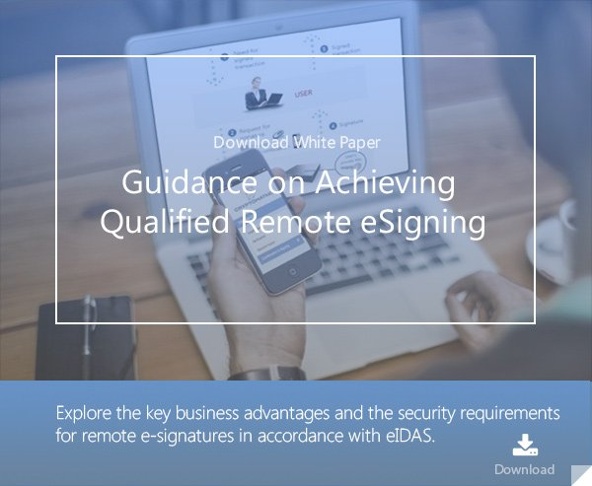3 min read
eIDAS – Proving a Competitive Advantage to Banks (Part 1 of 2)
 Gaurav Sharma (guest)
:
14. February 2019
Gaurav Sharma (guest)
:
14. February 2019

The financial services industry is no stranger to intense scrutiny as well as extreme competition. These two forces have shaped banks over the course of the last several decades, especially since FinTech start-ups and established BigTech firms have started encroaching upon traditional banking territory. This is why banks are always looking for tools and processes that can help them satisfy all stakeholders – especially the customers and regulators.
At this point, it might seem like FinTech is a threat for banks but that couldn’t be further from the truth. Turning threats into opportunities is what makes businesses great and with such great tools being provided by European regulators, the winners will be the early adopters. Today, we look at some of the competitive advantages that a whole-hearted embrace of eIDAS might provide to banks.
Prospecting
There are half a billion potential prospects for any business in the European Single Market. With eIDAS, cross-border service delivery is easier than ever before for banks, governments, SMEs and practically anyone willing to make the effort. By their very nature, banking products are “sticky”, which means that once you on-board a customer for one product, you are very likely to retain them due to the ongoing and continuous nature of your transactions with them.
This makes prospecting all the more lucrative for banks and this is why banks outspend most other industries when it comes to customer acquisition.
eIDAS provides the opportunity for prospect identification as well as initiating the on-boarding process digitally and securely.
Omni-channel Service Delivery
We are at a point in history where rather than one dominant channel of service delivery, consumers are exhibiting a preference for multiple such channels. For example, there is robust growth in both mobile and online channels for service delivery while a lot of people still like to visit the high-street to get what they need. When it comes to financial service, the variety is even greater with digital wallets, tablets, white label products in addition to point-of-sale machines, mobile, online, physical and so on.
 In such a complex and varied environment, the technological flexibility that eIDAS provides is really a godsend for developers. Rather than being straitjacketed into a very specific method of achieving trust, eIDAS allows for multiple approaches as long as the end result is the same.
In such a complex and varied environment, the technological flexibility that eIDAS provides is really a godsend for developers. Rather than being straitjacketed into a very specific method of achieving trust, eIDAS allows for multiple approaches as long as the end result is the same.
Secondly, having multiple channels for service delivery makes providing the adequate level of security much harder and expensive. eIDAS alleviates this problem by providing identification, authentication, digital signing and trust mechanisms that ensure robust security across all digital channels.
Consumer Protection
Digital threats are expected to cost the global economy as much as USD 6 trillion each year by 2021! Financial services, due to their very nature, are a prime target and banks have an obligation to provide the best possible safeguards to their clients. Judging from the European regulatory response over the last few years, it is clear that the EU is not hesitant to implement the reforms necessary to protect its citizens. Banks must capitalise on this opportunity and go above and beyond when it comes to customer protection. The added security in their operations would actually make them more competitive internationally as well.
We will continue this discussion in Part 2 of this series and look at process optimisations offered by eIDAS as well as some nifty new tools for banks.
References and Further Reading
- Selected articles on eIDAS (2014-today), by Gaurav Sharma, Guillaume Forget, Jan Kjaersgaard, Dawn M. Turner, and more
- Benefits of the eIDAS Toolbox – Case Studies from Various Industries (Part 1) (2018), by Gaurav Sharma
- Benefits of the eIDAS Toolbox – Case Studies from Various Industries (Part 2) (2018), by Gaurav Sharma
- Digital Trade and Trade Financing - Embracing and Shaping the Transformation (2018), by SWIFT & OPUS Advisory Services International Inc
- REGULATION (EU) No 1316/2013 establishing the Connecting Europe Facility, amending Regulation (EU) No 913/2010 and repealing Regulations (EC) No 680/2007 and (EC) No 67/2010(12/2013), by the European Parliament and the European Council
- Selected articles on Electronic Signing and Digital Signatures (2014-today), by Ashiq JA, Gaurav Sharma, Guillaume Forget, Jan Kjaersgaard , Peter Landrock, Torben Pedersen, Dawn M. Turner, and more
- Selected articles on Authentication (2014-today), by Heather Walker, Luis Balbas, Guillaume Forget, Jan Kjaersgaard, Dawn M. Turner and more
- eIDAS webinar 1: Using electronic Identification, Authentication and trust Services for Business (2018), by the European Commission
- The European Interoperability Framework - Implementation Strategy (2017), by the European Commission
- Proposal for a DIRECTIVE OF THE EUROPEAN PARLIAMENT AND OF THE COUNCIL amending Directive (EU) 2015/849 on the prevention of the use of the financial system for the purposes of money laundering or terrorist financing (2016), by the European Commission
- REGULATION (EU) 2016/679 on the protection of natural persons with regard to the processing of personal data and on the free movement of such data, and repealing Directive 95/46/EC (General Data Protection Regulation) (2016), by the European Parliament and the European Council
-
Proposal for a REGULATION concerning the respect for private life and the protection of personal data in electronic communications and repealing Directive 2002/58/EC (Regulation on Privacy and Electronic Communications), (2017), by the European Parliament and the European Council
- Revised Directive 2015/2366 on Payment Services (commonly known as PSD2) (2015), by the European Parliament and the Council of the European Union
- REGULATION (EU) No 910/2014 on electronic identification and trust services for electronic transactions in the internal market and repealing Directive 1999/93/EC (2014) by the European Parliament and the European Commission
-
DIRECTIVE 2013/37/EU amending Directive 2003/98/EC on the re-use of public sector information (2013) by the European Parliament and the Council
